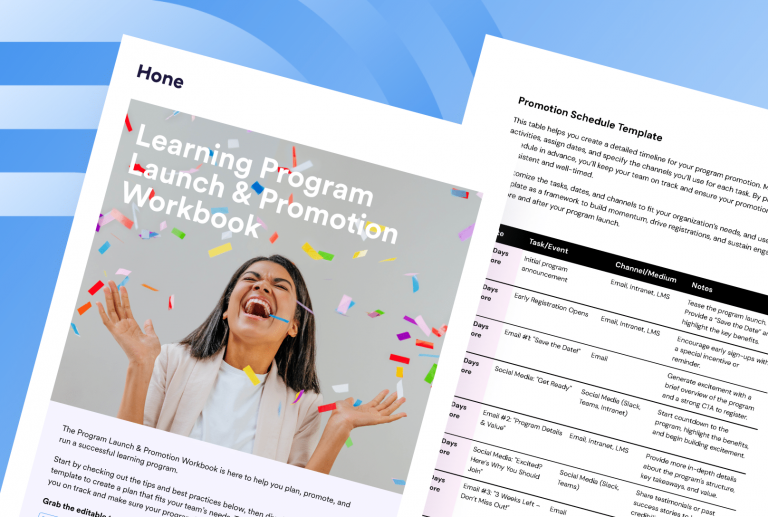What is Behavior Change?
The definition of behavior change refers to the process of modifying an individual’s actions, attitudes, and habits to improve their performance, productivity, and overall well-being in the workplace. Various factors can drive this change, such as feedback from colleagues, management, customers, personal development goals, or organizational initiatives. The goal of behavior change in the workplace is to create a positive work environment that fosters growth, innovation, and success for both individuals and the organization. Examples of behavior changes in the workplace may include improving communication skills, developing leadership qualities, adopting new technologies or processes, or promoting a healthier work-life balance.
The change can include alterations in actions, emotions, thinking, and relationships. Changes may be temporary or permanent. Managers and learning and development (L&D) personnel create training programs to modify employees’ behaviors to match organizations’ objectives.
What is the Behavior Change Theory?
The purpose of L&D training is to change behaviors in the workplace. Understanding how people behave can help employee improvement initiatives. Following a theoretical approach to behavior change works better than baseless attempts.
Organizations that incorporate well-studied theories can identify the key factors affecting employees’ ability to change behaviors. Select interventions work for some but not for others. So, it’s crucial to determine which proven paths work for a particular business or team.
Benefits of behavior change in the workplace:
- Increases employee satisfaction, which leads to lower turnover
- Saves time and improves team efficiency
- Higher profitability
- Improves workplace harmony
- Encourages a positive attitude towards work and L&D
Furthermore, continuous learning in the workplace drives education and behavior change. Behavioral change through learning programs is not a one-time event. Employees must go through a process to truly modify their behavior.
However, learning and behavior change are mutually dependent. Training can be in vain if employee behavior is against it.
3 Behavior Change Models and Theories
Social Cognitive Theory
Social Cognitive Theory (SCT) is the belief that is learning results from interactions between individuals, their environment, and behaviors. It’s built on the idea that when employees understand the risks and benefits, the precondition for change exists within them.
SCT identifies the following determinants of behavior:
- Capability: the person’s actual ability to perform a behavior
- Observation: the person witnessing others modeling the behavior
- Self-efficacy: the person’s confidence in their ability to complete a behavior
- Reinforcements: the internal and external responses to the person’s behavior
- Expectations: the anticipated consequences (the goal) of performing the behavior
SCT proposes that behavior is a deliberate act for seeking positive outcomes and avoiding negative ones. If employees don’t know how their habits affect the workplace, they don’t have a reason to endure the challenges of change.
Theory of Planned Behavior
The Theory of Planned Behavior (TPB) combines employees’ expectations about performing a behavior with the value that employers attach to that behavior. It links behaviors to beliefs. So, organizations can use it to predict motivational influences on behavior.
The TPB defines four main psychological factors affecting behavior change:
- Attitude – Positive or negative evaluation of performing a behavior
- Intention – Willingness to perform the behavior
- Subjective norms – Perceived social pressure to do or not do the behavior
- Perceived behavioral control – Belief concerning the ease or difficulty performing the behavior
The two strongest behavior predictors are intention and perceived behavioral control. Therefore, TPB seeks to understand an individual’s perception of the difficulty of the change, its benefits, and its potential for success.
The Transtheoretical Model
The Transtheoretical model (TTM) has ordered categories of motivational readiness to change problem behavior. TTM is based on different theories of psychotherapy. It is often utilized for health behavior change, such as stress management and depression prevention. However, it’s a method for an individual to make a professional change. Its highest workplace potential is to reduce change resistance and increase employee participation. The change process is a set of variables that transition individuals between the five stages.
5 Stages of Behavior Change with The Transtheoretical Model:
Stage 1 – Precontemplation is when the employee has no intention to change behavior in the foreseeable future. Many individuals in this stage need to be made aware of their problems.
Stage 2 – Contemplation occurs when people know a problem exists and consider overcoming it. But they still need to commit to taking action.
Stage 3 – Preparation combines intention and behavioral criteria. Workers in this stage gather information to make plans to take action soon.
Stage 4 – Action is when individuals modify their behavior, experiences, or environment to overcome problems. Action requires considerable commitment of time and energy.
Stage 5 – Maintenance is when people work to prevent relapse. They consolidate the gains attained during the action stage.
5 Behavior Change Techniques for the Workplace
1. Provide Clear Goals
Clear goals direct actions and efforts toward a desired behavior. A clear objective allows employees to monitor their progress and correct steps as necessary. Employees can feel more energized and motivated if they know what behaviors to display. Likewise, they can track their results and identify barriers to achieving the desired result.
Managers should repeat goals frequently to drive behavioral change. For example, leaders can repeatedly display goals through public communication channels, such as signage, for group behavior change.
2. Inspire Staff
Inspiration is one of the best ways to drive behavior changes. Leaders can use inspirational language and share stories. Managers can also work with employees at an individual level to:
- Identify their passions and motivations.
- Connect with them.
- Evoke a sense of desire to change.
Organizations can also inspire workers on a larger scale. For instance, L&D leaders can create a digital newsletter with employees’ testimonials and personal experiences related to the behavior change. These discussions of accomplishments and challenges increase their colleagues’ motivation.
3. Reinforce Positive Behaviors
Rewards drive and motivate employees’ behavior change. Therefore, managers should acknowledge and recognize employees who display the desired behavior.
Recognition and reward also outline what success looks like for other workers. Praising employees privately and publicly enables colleagues to display similar behavior in the future.
Furthermore, leaders must provide constructive and direct feedback in private immediately when direct reports display undesirable behavior. Giving constructive feedback as a manager boosts engagement and drives change.
4. Advocate for Group Change
A single employee working on their behavior must generate self-motivation. Often, behavior change is easier when done as a team. Group mentality creates a sense of unity and positive peer pressure. In addition, individuals are more likely to want to change their behavior when they see their colleagues change.
Behavior change can occur by observing the actions of others, according to Social Learning Theory.—individualsmodel behavior by observing others. New hires learn how to behave by watching coworkers. Observational learning also includes hearing or reading verbal instructions.
5. Take One Step at a Time
The most effective approach to facilitating employee behavioral change is to tackle one issue at a time. Unfortunately, trying to change multiple behavior issues at once can be overwhelming.
Additionally, employees need time to adjust to a new habit to ensure it is a permanent change. Just because an employee learned something does not mean it will result in a permanent behavior change.
Managers can prioritize the behaviors to change and single out the most important. Then, they can coach the employee on changing that issue specifically. The first new behavior must be permanent before moving on.
5 Behavior Change Strategies for the Workplace
1. Experiential Learning
Experiential learning allows participants to roleplay and participate in simulations conducive to behavior change. Employees can practice new behaviors in experiential learning cohorts. These are safe spaces where they practice new behaviors and receive feedback.
2. Feedback
Feedback helps reinforce employees’ positive behaviors and can correct the wrong behaviors. The feedback loop is a team effort from managers, training teams, and coaches.
3. Follow-up
When workers can follow up, ask questions, and try again, they are more likely to achieve desired behavior changes. In addition to behavior change, follow-up is critical after performance reviews and other goal-setting initiatives.
4. Nudges
Strategically placed microlearning opportunities serve as reminders. Small nudges throughout the workflow are effective at helping to modify employees’ behavior. For example, short videos and infographics shared through a social learning platform refresh the behaviors learned in formal training.
5. Modeling
Modeling serves as an effective method of changing employee behavior in the workplace. Follow-up messages from leaders remind employees of expected behaviors and reduce undesired ones. They can also help modify norms and reward appropriate actions.
Behavior Change Examples
Employee behavior can drive the success of organizations. Certain behaviors affect business metrics and results. The following are 12 types of workplace behaviors:
- Leadership
- Creative-thinking
- People-pleasing
- Playful
- Analytical
- Assertive
- Isolating
- Introverted
- Referent leadership
- Aggressive
- Passive communication
- Passive-aggressive











